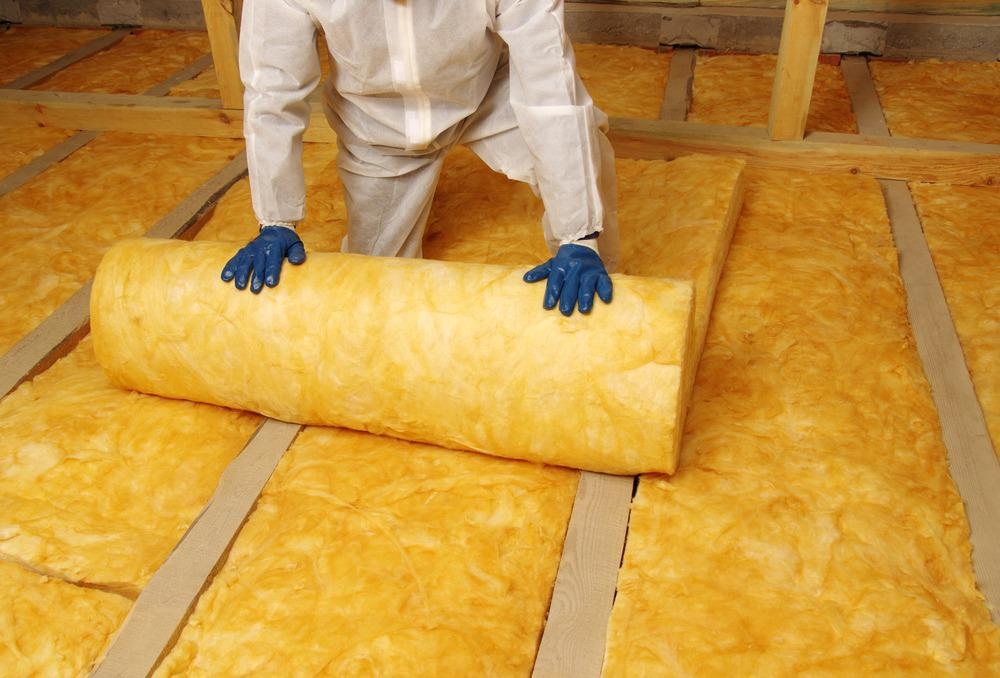There is a wealth of options when it comes to building insulation materials. Bulky fiber materials like fiberglass and cotton, rigid foam boards, polyurethane, and straw all get used in different insulation applications in the construction industry. This article explores some of the insulation materials in use today.

Image Credit: irin-k/Shutterstock.com
Cellulose Insulation Material
Cellulose insulation is made out of recycled paper, with a high ratio of recycled material at between 82% and 85%. To make it, paper (usually newsprint) is shredded and then fiberized. The final product can be tightly packed into building cavities.
Borate (sometimes mixed with ammonium sulfate, which is cheaper) is added to create fire and insect resistance.
Dry cellulose can be blown into cavities in existing buildings and structures to retrofit insulation in the building. In new constructions, it can be damp sprayed into cavities as they are being built or installed dry with a layer of netting already stapled for support.
Cementitious Foam Insulation Material
Cementitious foam is a cement-based foam material that can be either sprayed onto surfaces or foamed in place. Sometimes, magnesium silicate is included with the cement mix to create a shaving cream-like application consistency.
Cementitious foam is applied to surfaces and inside cavities, where it sets and provides insulation. Cementitious foam is nontoxic, nonflammable, and can be made sustainably.
Cotton
Cotton insulation is another type of recycled insulation that can help construction projects reduce their carbon footprints. It generally contains about 85% recycled cotton and 15% plastic fibers treated with flame retardant borate. It is available in batts and thick sheets of insulation.
Facings
Facings protect the surface of other insulation materials, hold them together, and enable them to be fastened to building materials.
Some facing types can also work as air barriers, radiant barriers, and vapor barriers. Some even provide additional fire resistance.
Facings are typically made with craft paper or aluminum foil.
Fiberglass
Fiberglass contains fine glass fibers and is the most common insulation material used today. It comes in blanket form in batts or whole rolls, can be loose-filled, and can be included in rigid boards and duct insulation.
Fiberglass batts are produced at different densities to give higher R-value ratings. High-density products are for places with limited cavity space such as cathedral ceilings.
(An insulating material’s R-value is a measure of how well it resists conductive heat flow. A higher R-value denotes better insulating performance. R-value depends on insulation type, thickness, and density, as well as the environmental temperature, moisture accumulation, aging, and deterioration in the material.)
Fiberglass insulation is made out of molten glass that has been spun into fibers, usually with about 50% recycled glass.
Mineral Wool
Mineral wools are synthetic materials made out of natural minerals like basalt or diabase or waste material from blast furnaces (slag).
Mineral wools generally contain about 75% recycled material from industrial processes and do not require any treatment to make them fire-resistant. Mineral wool is available in batts, rolls, and as loose-fill insulation.
Perlite Insulation Materials
Perlite contains small, lightweight pellets that make loose-fill insulation that can be poured into place or mixed with cement to make lightweight, insulating concrete. It is typically found in homes built before 1950.
Polyisocyanurate
Polyisocyanurate, also known as polyiso, is a type of plastic, closed-cell foam that sets under heat. It contains an insulating, hydrochlorofluorocarbon-free gas in its cells. The R-value of polyisocyanurate drops over time as the gas escapes.
It is available as a liquid, as sprayed foam, and in rigid foam boards. It can be included in laminated insulation panels with various facings to improve the panels’ performance.
It is also sometimes used as the insulating layer in structural insulated panels. These are prefabricated building panels that can be made in a factory to ensure maximum thermal efficiency in the finished building and are popular with the passive house movement.
Polystyrene
Polystyrene is routinely used for foam board insulation, beadboard insulation, concrete block insulation, and as loose-fill insulation with small polystyrene beads.
Polystyrene’s R-value depends on its application density. Loose-filled polystyrene beads generally provide less thermal insulation than rigid foam boards, for example.
Polyurethane Insulation Materials
Polyurethane contains an insulating gas in its cells. The gas helps the foam to expand in application and fill the spaces it meets. Polyurethane insulation’s R-value can fall over time as it ages, with insulating gas leaking in the same process as polyisocyanurate. Foil and plastic facings are employed to slow down the aging process.
Straw
Straw bale construction is a centuries-old technique that has been popular throughout Europe and North America.
Traditional straw bale construction methods are still practiced by a small community of self-builders. These techniques are used to build walls out of entire straw bales, providing structural support and insulation at once from a renewable source.
Straw insulation can also be added to conventional buildings. It is available in panels between 5 mm and 100 mm thick and faced with heavy craft paper on each side. Straw insulation boards make good soundproofing panels.
Modern structural straw insulation panels have been developed by manufacturers looking to revitalize the old technique and capitalize on its green building potential. These contain multiple layers of compressed straw panels fused together without adhesives.
More from AZoBuild: A to Z of Glass Types for Construction
References and Further Reading
US DoE. How Insulation Works. [Online] United States Department of Energy. Available at: https://www.energy.gov/energysaver/insulation
Insulation Materials. [Online] United States Department of Energy. Available at: https://www.energy.gov/energysaver/insulation-materials
Types of Insulation. [Online] United States Department of Energy. Available at: https://www.energy.gov/energysaver/types-insulation
Disclaimer: The views expressed here are those of the author expressed in their private capacity and do not necessarily represent the views of AZoM.com Limited T/A AZoNetwork the owner and operator of this website. This disclaimer forms part of the Terms and conditions of use of this website.